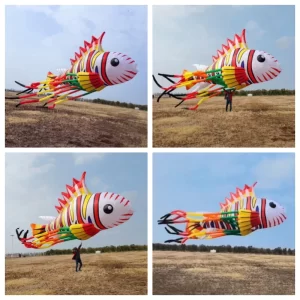
Quad line kites offer an exhilarating kite flying experience, providing unparalleled control and versatility. Whether you’re a seasoned flyer or just starting, learning to master a quad line kite opens up a world of aerial acrobatics and precision flying. In this blog post, we’ll guide you through the basics of controlling and flying a quad line kite, ensuring you get the most out of your time in the sky.
Quad line kites have four lines, giving you the ability to control the kite’s angle to the wind. This allows for precise control over speed, direction, and pull. Unlike traditional two-line kites, quad line kites can:
The added control makes quad line kites ideal for tricks, stunts, and even team flying. Here’s how to get started:

1. Choose the Right Kite:
For beginners, we recommend starting with a kite like the Freilein Transeye 2.4m Quad Line Stunt Kite, available at KiteUSA.com. It’s designed for intermediate to competition-level flyers, providing a balance of durability and performance.
2. Line and Handle Setup:
Your kite will come with four lines and a set of handles. Typically, the lines are color-coded to ensure proper attachment. Here’s a basic setup guide:
3. Wind Conditions:
Quad line kites can fly in a wide range of wind conditions, typically from 2 to 20 mph. Check the wind speed before heading out to ensure optimal flying conditions.
1. Ground Setup:
Lay your kite on its back, with the leading edge facing away from you. Ensure that all lines are untangled and securely attached to the kite and handles.
2. Position Yourself:
Stand with your back to the wind. This positioning allows the wind to catch the sail and lift the kite.
3. Pre-Flight Check:
Before launching, make sure all lines are taut and the kite is responsive to gentle tugs on the handles.
4. Assisted Launch:
For beginners, an assisted launch can be helpful. Have a friend hold the kite while you gently pull back on the handles, allowing the wind to lift it into the air.
1. Lifting Off:
Gently pull back on the top lines (left and right) to lift the kite. As the kite rises, maintain steady tension on the lines to keep it stable.
2. Hovering:
To hover, find the balance point by adjusting the tension on the top and bottom lines. This allows the kite to stay in one spot, hovering mid-air.
3. Forward and Backward Flight:
4. Turning:
5. Spins and Rotations:
1. Sideways Flight:
Quad line kites can move sideways by adjusting the tension on one side’s lines while maintaining steady control on the opposite side.
2. Wing Tip Pivots:
To pivot on a wing tip, pull back sharply on one top line while pushing forward on the opposite bottom line. This will cause the kite to pivot around its tip.
3. Precision Landings:
To land your kite, gently decrease the tension on the top lines while maintaining slight tension on the bottom lines, allowing the kite to descend smoothly.
1. Practice Makes Perfect:
Spend time practicing basic maneuvers before attempting advanced tricks. Building muscle memory and understanding the kite’s responsiveness is key to mastering control.
2. Wind Awareness:
Always be aware of the wind conditions. Strong gusts can make controlling the kite more challenging, while very light winds might require more effort to keep the kite aloft.
3. Safety First:
Fly in open areas away from obstacles and other people. Always wear protective gear, such as gloves, to prevent line burns.
4. Maintenance:
Regularly check your kite for any signs of wear and tear. Ensure lines are not frayed, and the frame is intact to maintain optimal performance.
Flying a quad line kite is a thrilling and rewarding experience. With practice and patience, you’ll be able to perform intricate maneuvers and enjoy the full capabilities of your kite. Visit KiteUSA.com to explore our range of high-quality kites and accessories, and take your kite flying to new heights! Happy flying!







